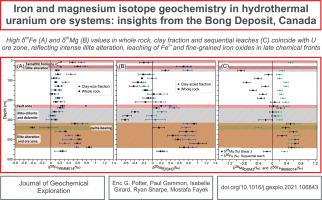Journal of Geochemical Exploration ( IF 3.9 ) Pub Date : 2021-06-16 , DOI: 10.1016/j.gexplo.2021.106843 Eric G. Potter , Paul Gammon , Isabelle Girard , Ryan Sharpe , Mostafa Fayek

|
The basement-hosted Bong uranium deposit in the Kiggavik region is associated with a broad hydrothermal alteration halo characterized by an inner illite-rich zone and an outer chlorite-rich zone. The uranium-bearing zones characterized by intense illite alteration yield high δ56Fe and δ26Mg values relative to the host rocks, with average whole-rock values of δ56Fe = 0.58 ± 0.15‰ and δ26Mg = 0.61 ± 0.29‰, and clay-size fraction values of δ56Fe = 0.51 ± 0.20‰ and δ26Mg = 0.82 ± 0.09‰. These isotopic values correlate with a decrease in average Fe2+ concentrations (0.47 versus 2.30 mol% Fe2+ in least-altered hosts).
The high δ26Mg values reflect intense illite alteration, which preferentially incorporated heavier magnesium isotopes during alteration of both the ore zones and an upper hematite-altered horizon. Although the clay alteration with high δ56Fe and δ26Mg values coincides with the main uranium-bearing zone, the δ56Fe signatures reflect multiple stages of alteration and mineralization. The high δ56Fe values and lower Fe2+ contents of the uranium-bearing zones support leaching of Fe2+(aq) enriched in lighter iron isotopes. Sequential leach δ56Fe experiments also indicate that formation of fine-grained iron oxides/hydroxides with positive δ56Fe values (+0.23 to +0.60‰) in late chemical fronts enhanced the primary positive δ56Fe signatures recorded in ore zones. Near surface samples with similar isotopic signatures provide clues to buried mineralization and support structural disruption of the systems after primary mineralization. Distal geochemical expressions of this system may include enrichment in iron contents with negative δ56Fe values and/or negative δ26Mg whole-rock or clay-size fractions values, reflecting precipitation of the isotopically light iron and magnesium leached during hydrothermal alteration. Although more costly to process, sequential leach δ26Mg or δ56Fe analyses produced greater variance in the ore zones relative to background values and removed anomalous values from carbonate minerals. Isotopic analyses of the clay-size fraction produced results comparable to the final digestion in the sequential leach process but this method in particular requires greater understanding the mineralogical controls on the isotopic signatures.
中文翻译:

热液铀矿系统中的铁和镁同位素地球化学:来自加拿大 Bong 矿床的见解
Kiggavik 地区位于基底的 Bong 铀矿床与一个广泛的热液蚀变晕有关,其特征是内部富含伊利石带和外部富含绿泥石带。以强烈伊利石蚀变为特征的含铀区相对于母岩产生较高的δ 56 Fe 和δ 26 Mg 值,δ 56 Fe 的平均全岩值= 0.58 ± 0.15‰,δ 26 Mg = 0.61 ± 0.29‰ , 以及 δ 56 Fe = 0.51 ± 0.20‰ 和 δ 26 Mg = 0.82 ± 0.09‰ 的粘土粒度分数。这些同位素值与平均 Fe 2+浓度的降低相关(0.47 与 2.30 mol% Fe 2+在最少改变的宿主中)。
高δ 26 Mg 值反映了强烈的伊利石蚀变,在矿区和上赤铁矿蚀变层位的蚀变过程中,伊利石优先掺入了较重的镁同位素。尽管具有高 δ 56 Fe 和 δ 26 Mg 值的粘土蚀变与主要含铀带重合,但 δ 56 Fe 特征反映了蚀变和成矿的多个阶段。含铀区的高 δ 56 Fe 值和较低的 Fe 2+含量支持了富含较轻铁同位素的 Fe 2+ ( aq ) 的浸出。顺序浸出 δ 56Fe 实验还表明,在晚期化学锋中形成具有正 δ 56 Fe 值(+0.23 至 +0.60‰)的细粒氧化铁/氢氧化物增强了矿带中记录的主要正 δ 56 Fe 特征。具有相似同位素特征的近地表样品提供了埋藏矿化的线索,并支持原生矿化后系统的结构破坏。该系统的远端地球化学表达式可能包括铁含量的富集,δ 56 Fe 值为负和/或 δ 26 Mg 全岩或粘土粒度分数值为负,反映了在热液蚀变过程中浸出的同位素轻铁和镁的沉淀。虽然处理成本更高,但顺序浸出 δ26 Mg 或 δ 56 Fe 分析在矿区中相对于背景值产生了更大的变化,并从碳酸盐矿物中去除了异常值。粘土尺寸部分的同位素分析产生的结果与顺序浸出过程中的最终消化相当,但这种方法尤其需要更深入地了解对同位素特征的矿物学控制。


























 京公网安备 11010802027423号
京公网安备 11010802027423号